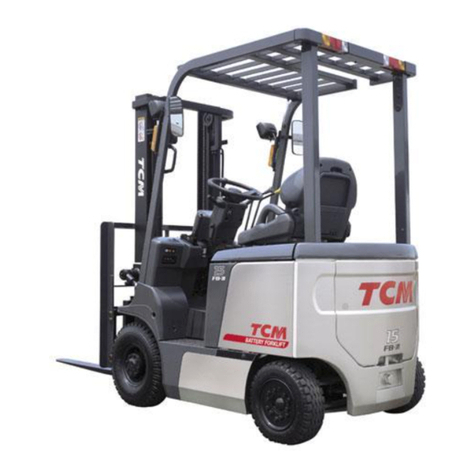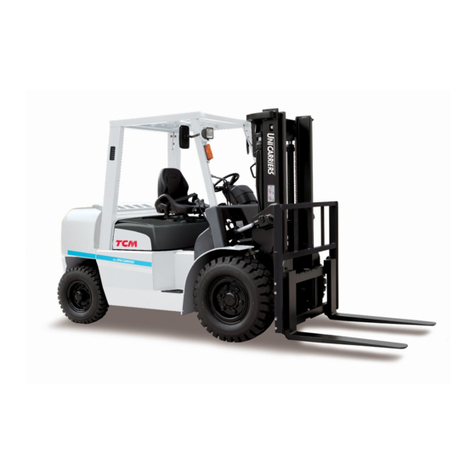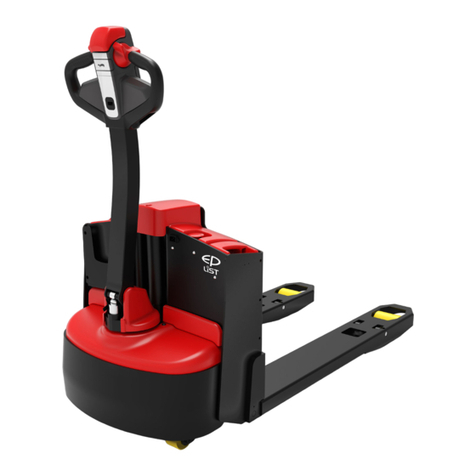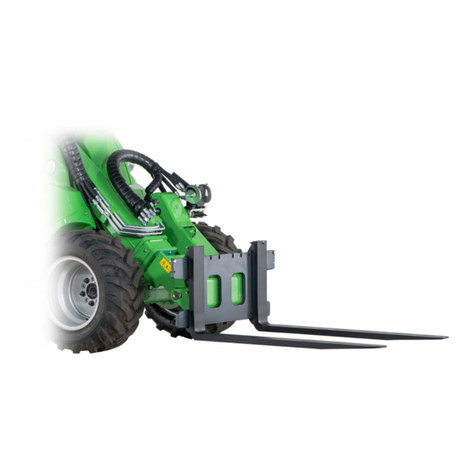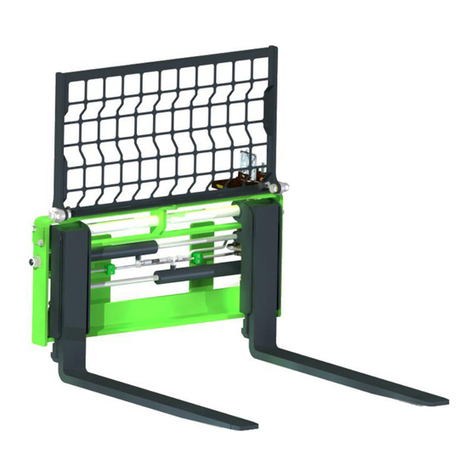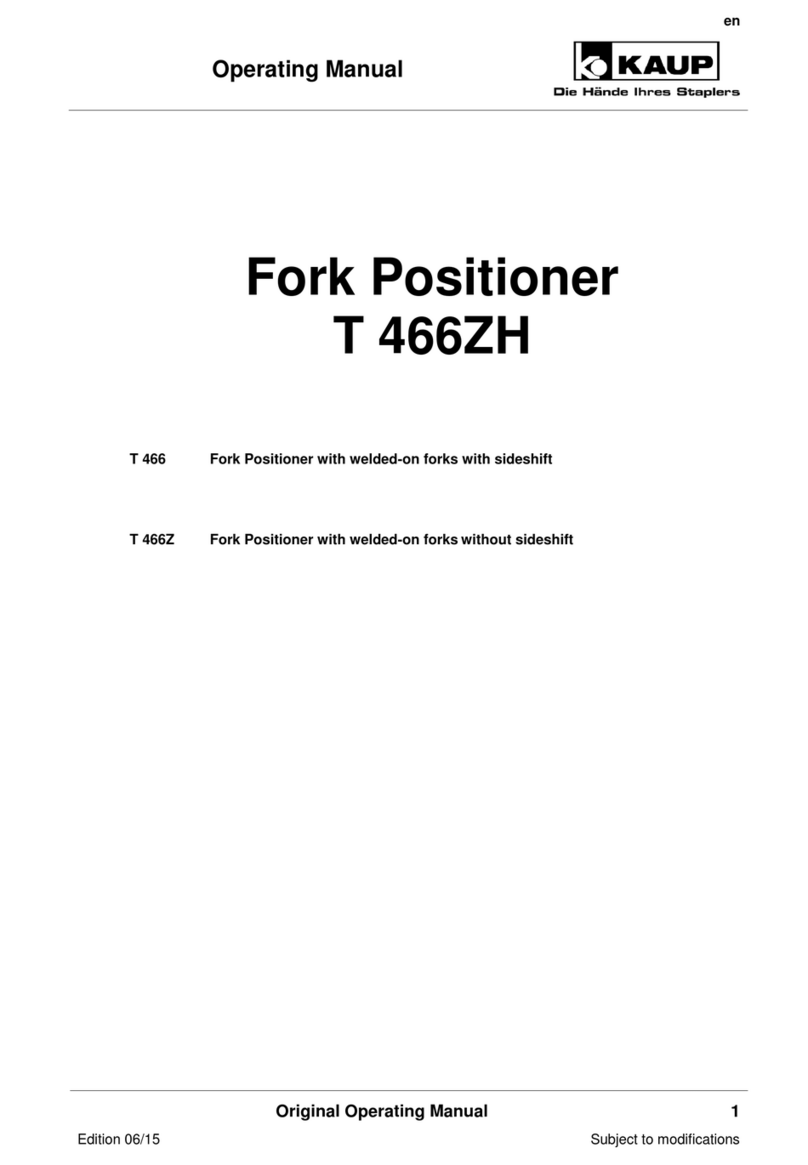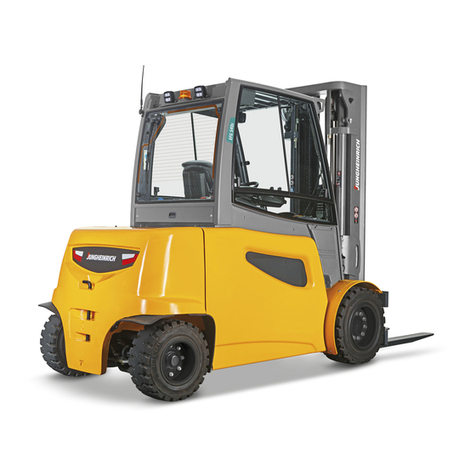TCM FB10-7 Manual

Мо.
ОВ-81ВАЕ
<ДМ-
-FB(10-
15-
il
|
OPERATION!
@,
-
MAINTENANCE
MANUAL
ELECTRIC
FORKLIFT
TRUCK
Counter-balanced
type
FB10-7
ҒВ25-т.в
FB15.7
FB25.7v
FB20-7
FB30-7v
|
FB25.7
|
|
FB30-7
•
It
is
the
responsibility
of
the
Operator
&
Supervisor
to
read
and
understand
this
manual.
A
е
Protect
the
earth
and
be
kind
to
your
lift
truck.
TCM
CORPORATION

Thank
you
very
much
for
your
purchase
of
TCM’s
product.
This
Operation
&
Maintenance
Manual
was
written
to
provide
the
owner/operator
with
information
about
the
safe
operation
and
maintenance
of
the
TCM
forklift
truck.
Read
this
manual
thoroughly
and
become
completely
familiar
with
the
lift
truck
before
using
it.
If
you
have
any
questions,
see
your
dealer.
This
manual
was
compiled
based
on
the
standard
models.
For
trucks
other
than
the
standard
models,
only
the
differences
are
explained.
Due
to
improvements
in
design,
it
is
possible
that
the
description
contained
herein
may
not
completely
apply
to
the
truck
delivered
to
you.
Rona
ee
If
the
truck
is
to
be
leased,
loaned
or
sold
to
anyone,
this
manual
must
be
with
the
truck.
.
oe
D
CONTENTS
1.
SAFETY
2.
OPERATING
CONTROLS
3.
OPERATION
4.
MAIN-
TENANCE
5.
SPECIFICA-
TIONS
&
SERVICE
DATA


1.
SAFETY
CONTENTS
FOR
SUPERVISORS
..............
sesenta
1-
1
PROPER
AND
IMPROPER
USES
.............................
1-
2
PLANNING
AND
WORKING
AREA
...........................
1-
3
TRAVELING
ON
PUBLIC
ВОАРЗ..............................
1-
6
OPERATORS;
sinite
regen
esie
ei
1-
7
TYPES
OF
VEHICLES
AND
LOADS
....
д
1-
9
INSPECTION...
nei
E
RR
RUN
ERN
1-12
TRANSPORTING
THE
LIFT
TRUCK
.........................
1-13
HOW
THE
LIFT
TRUCK
WORKS?
...................................
1-14
TRAVELING
................
LOAD
HANDLING
РАНКЇМО:.
у.
tet
er
erras

This
manual
and
the
decals
affixed
to
the
truck
use
the
following
safety
alert
indications.
SIGNAL
WORD
CLASSIFICATION
Failure
to
follow
the
instructions
in
the
message
A
DANGER
will
likely
cause
a
serious
accident
or
death.
Failure
to
follow
the
instructions
in
the
message
A
WARNING
might
cause
a
serious
accident
or
death.
Failure
to
follow
the
instructions
in
the
message
A
CAUTION
|
may
cause
personal
injury
or
damage
to
the
truck
or
other
property.
The
information
will
help
to
prolong
the
service
^en
NOTE
life
of
the
truck.
The
message
is
not
directly
related
to
accident
prevention.
Forward
€&
»
Backward
The
diagram
above
indicates
the
meanings
of
the
terms
"forward",
"backward",
"right"
and
"left"
used
in
this
manual.
FOR
SUPERVISORS
Lift
truck
accidents
cause
dozens
or
hundreds
of
deaths
every
year,
and
even
greater
numbers
of
personal
injuries.
TCM
has
steadily
improved
the
design
and
fabrication
of
our
lift
trucks
so
they
may
be
used
more
safely
and
efficiently,
but
many
accidents
still
occur
due
to
improper
use.
Accidents
are
often
the
result
of
more
than
just
"bad
driving".
The
use
of
inappropriate
types
of
equipment,
the
selection
of
inappropriate
attachments
or
accessories,
inappropriate
operating
environments,
careless
designation
of
operators,
and
failure
to
properly
train
the
operator
are
other
common
causes
of
accidents.
This
chapter
covers
the
methods
of
accident
prevention
which
are
primarily
the
responsibility
of
supervisory
personnel.
•
Pages
1-
2
through
1-13
contain
instructions
which
should
be
enforced
by
the
personnel
supervising
the
operation
of
the
lift
truck.
Please
make
sure
the
operators
also
read
these
pages.
•
Page
1-14
and
the
following
pages
contain
specific
precautions
directly
related
to
the
operation
of
the
lift
truck.

FOR
SUPERVISORS
|
PROPER
AND
IMPROPER
USES
Ш
PROPER
USE
OF
THE
LIFT
TRUCK
B
IMPROPER
USE
The
proper
use
of
a
lift
truck
is
to
transport
a
load
which
is
placed
Transporting
a
person,
elevating
a
person,
and
towing
another
on
the
pallet
and
stacked
within
the
prescribed
height
limit.
vehicle
are
examples
of
the
improper
use
of
a
lift
truck.
Uses
which
With
a
proper
attachment,
a
lift
truck
may
be
used
to
transport
a
this
manual
specifies
as
improper
must
never
be
requested
or
load
which
is
stacked
elsewhere
than
on
the
pallet.
permitted,
under
any
circumstances.
(Examples
of
Improper
Use)
е
Transporting
or
elevating
a
person
on
the
forks
or
pallet.
*
Carrying
a
person
on
the
pallet
to
control
the
load.
e
Hanging
а
cable
on
the
forks
to
suspend
a
load.
*
Towing
another
vehicle.
e
Pushing
a
load
or
another
vehicle
with
the
forks.
e
Using
the
forks
or
truck
body
to
close
or
open
the
door
of
a
freight
vehicle.

КОН
SUPENVISUND
|
PLANNING
AND
WURKING
AHEA
|
i
MAKE
AN
OPERATING
PLAN
AND
DISCUSSIT
Ш
INSTALL
CURBS
OR
RAILINGS
Before
using
the
lift
truck,
plan
out
the
travel
routes
and
operating
If
the
truck
is
to
be
used
on
a
loading
dock,
shore
wall
or
other
procedures,
and
thoroughly
discuss
the
details
with
all
personnel
raised
surface,
install
curbs
or
railings.
involved
.
;
B
MARK
THE
TRAVEL
LANES
Ш
SET
SPEED
LIMITS
(Example)
Yard
Speed
Limit
Designate
the
travel
lanes
for
the
lift
truck
and
mark
them
clearly,
Set
appropriate
speed
limits
on
your
company
grounds,
and
post
so
they
will
be
kept
free
of
obstruction.
signs
that
are
clearly
visible.
1-3

FOR
SUPERVISORS
|
PLANNING
AND
WORKING
AREA
Ш
KEEP
PEOPLE
OUT
OF
THE
OPERATING
AREA
Closed
to
Pedestrians
No
Pedestrians
No
other
personnel
should
be
allowed
in
areas
where
the
lift
truck
is
used.
Where
other
people
must
be
present,
post
a
guide
whose
job
is
to
make
sure
people
stay
clear
of
moving
vehicles.
Ш
KEEP
UNAUTHORIZED
VEHICLES
OUT
Unauthorized
vehicles
must
be
kept
out
of
the
load
handling
areas.
Post
signs
or
give
signals
as
required.
Ш
KEEP
THE
GROUND
LEVEL
AND
DRY
VESD
Ш
JENS
Be
sure
that
all
areas
where
the
lift
truck
travels
are
level
and
regular.
Clear
away
pools
of
oil
or
water.
Ш
PROVIDE
ADEQUATE
LIGHTING
Safe
operation
requires
well-lit
traveling
routes,
so
pedestrians
and
obstacles
can
be
easily
seen.
Use
headlights,
taillights,
helmet
lamps
or
other
lights
as
appropriate.

FOR
SUPEHVISURD
|
PLANNING
AND
WORKING
AHEA
|
Ш
ASSIGN
TRAFFIC
GUIDES
TO
CONGESTED
Ш
PROVIDE
AND
MAINTAIN
EMERGENCY
AREAS
EQUIPMENT
(Example)
еф
H
Jd
FIRE
EXTINGUISHER
жа.
ж.
шу
fen
HOW
TO
OPERATE
ORDINARY
OIL
ELECTRIC
peeti
PULL
OUT
SAFETY
РИ
Fire
extinguishers
and
first
aid
kits
should
be
provided
and
maintained
for
use
in
case
of
a
fire
or
accident.
All
personnel
should
Post
a
traffic
guide
in
confined
or
congested
areas
where
other
understand
the
location
and
use
of
emergency
equipment.
people
or
vehicles
may
pass.
All
personnel
must
obey
the
guide.
Ш
KNOW
WHO
ТО
CALL
IN
AN
EMERGENCY
Ш
SAFETY
MEASURES
FOR
DANGER
SPOTS
Emergency
Number
1.
Fire
2.
Earthquake
3.
Ambulance
Post
warning
signs
or
take
other
appropriate
measures
to
ensure
Keep
information
on
hand
to
allow
immediate
calls
for
help
in
case
that
lift
truck
operators
keep
away
from
danger
spots
as
they
travel.
of
a
fire,
accident
or
other
emergency.
1-5

FOR
SUPERVISORS
|
TRAVELING
ON
PUBLIC
ROADS
Ш
СОТ
A
LICENSE?
m
NO
LOAD,
NO
TOWING
It
is
usually
illegal
to
carry
a
load
on
a
public
road.
It
is
also
not
allowed
to
tow
another
vehicle
on
a
public
road
(with
the
possible
exception
of
a
disabled
vehicle).
Never
tow
another
vehicle,
even
on
company
property.
Ш
OBEY
TRAFFIC
LAWS,
AND
TURN
OFF
YOUR
LIGHTS
Before
traveling
on
a
public
road,
be
sure
that
the
truck
has
been
licensed
and
inspected
as
required
by
local
laws.
On
a
public
road,
the
lift
truck
must
obey
the
same
laws
as
any
other
vehicle.
Do
not
use
rear
working
light
or
tail
lamp.

FUR
SUPENVISDUND
|UPEHAIUHS
Ш
WEAR
PROTECTIVE
GEAR
•
Always
wear
proper
work
clothes
for
driving.
Work
clothes
should
be
designed
to
prevent
any
part
from
accidentally
catching
on
knobs
or
other
parts
of
the
truck
or
equipment.
For
example,
shirts
and
trousers
should
have
tight
cuffs.
e
Always
wear
a
hard
hat
and
safety
shoes.
•
Wear
other
protective
gear
as
appropriate
to
the
conditions
of
the
work
site,
i.e.,
goggles
or
gloves.

Ш
TRAIN
YOUR
STAFF
TO
STACK
SAFELY
“Stacking”
means
piling
palleted
load
or
materials
directly
on
top
of
each
other,
without
using
racks
or
shelves
to
separate
them.
ІР
the
stacking
work
is
not
done
properly,
the
loads
may
slip
or
fall,
endangering
the
operator
as
well
as
any
other
personnel
in
the
area.
Safety
classes
should
be
held
to
train
all
operators
in
the
proper
methods
of
stacking
and
unstacking
loads.
(Your
TCM
dealer
can
provide
information
about
training
for
safe
stacking.)
FOR
SUPERVISORS
B
TIRED
OR
UNWELL?
SEND
THEM
HOME!
Do
not
let
people
take
chances.
An
operator
who
is
overworked
or
fatigued,
an
operator
who
is
feeling
unwell,
or
an
operator
who
is
intoxicated
must
not
be
allowed
in
the
driver's
seat.

РОН
SUPERVIDUND
|
ТҮРЕ5
OF
VEHICLES
AND
LUAUS
|
Ш
USE
THE
RIGHT
TRUCK
FOR
THE
JOB
Ш
USE
THE
PROPER
ATTACHMENT
Be
sure
the
type
and
capacity
of
the
lift
truck
is
suitable
for
the
Popular
Attachment
Examples
work
environment.
г
Choi
Check
Point
hoice
Roll
Clamp
(For
paper
roll
or
drum
handling)
Rotating
Fork
(For
dumping
work
or
charging
work)
Capacity
Load
capacities
range
from
0.5
to
42
tons.
Pay
particular
attention
to
the
load
center.
(TCM
Lift
Truck
Capacities:
0.5, 0.7, 0.9,
1,
1.35,
1.5,
2,
2.25,
2.5,
2.75,
3,
3.5,
4,
4.5,
Б, 6,
7,
8,
10,
O9
ө 9
10.5,
11.5,
12,
13.5,
15, 18,
20,
22,
23,
24,
25,
30,
Hinged
Fork
37,
or
42
tons.)
(for
lumber
handling)
Side
Shift
(For
precise
stacking
in
containers
or
other
narrow
spaces)
Crane
Arm
(For
slinging
work)
Power
Source
Gasoline,
natural
gas,
diesel,
and
battery-powered
models
are
available.
Fuel
costs
and
exhaust
composition
will
vary.
9
Balance
On
counterbalanced
models,
the
counterweight
at
the
rear
makes
the
vehicle
longer
than
a
reach
truck.
A
reach
truck
performs
loading
and
unloading
by
extending
the
front
part
of
the
mast
outward,
which
gives
it
the
advantage
of
compactness.
Tires
For
indoor
use,
there
are
models
with
solid
tires
?
\
(best
for
reach
trucks)
and
cushion
tires
(engine
ў
eS
ЖА.
|
ASN
“i
type
or
battery
type).
Both
are
compact.
жок
For
outdoor
use,
pneumatic
tires
work
well.
Solid
pA
em.
А
cushion
tires,
with
the
same
dimensions
ав
55
5
pneumatic
tires,
may
be
the
best
choice
in
cases
where
the
load
materials
or
surface
conditions
could
puncture
pneumatic
tires.
A
WARNING
Flammable
Materials
|
For
handling
flammable
materials
such
as
Avoid
hoisting
a
load
with
wire
rope
hung
from
the
forks
petrochemicals,
a
combustion
engine
is
too
or
an
attachment,
or
avoid
lifting
a
freight
container
with
dangerous.
An
electric
vehicle
with
explosion-
proof
or
safety-reinforced
construction
is
required.
forks,
because
there
is
danger
of
the
truck
tipping.
If
(A
battery
power
source
always
offers
better
necessary,
have
a
qualified
operator
use
a
hook
or
crane
protection
against
fire
than
a
combustion
engine.)
arm
attachment.

FOR
SUPERVISORS
[TYPES
OF
VEHICLES
AND
LOADS
Ш
NO
OPERATION
WITHOUT
LIGHTS,
OVERHEAD
GUARD,
OR
LOAD
BACKREST
The
lift
truck
cannot
be
used
if
the
headlights,
taillights,
overhead
guard,
load
backrest,
horn
or
turn
signals
have
been
removed.
Any
parts
that
have
been
temporarily
removed
for
some
reason
must
be
reattached
immediately.
Ш
OBTAIN
APPROVAL
FOR
ANY
MODIFICATION
Do
not
add
counterweight
without
approval.
Modifications
or
additions
that
affect
the
capacity,
construction
or
strength
of
the
truck
must
not
be
performed
by
the
user
without
the
manufacturer's
prior
permission.
For
example,
don't
add
a
counterweight.
Ш
KEEP
DECALS
LEGIBLE
пакптааккталяввиаут
st
сеа
|
амапимиманантсаповастбкп
плеянспит,
The
decals
on
the
truck
describe
safety
precautions
and
operating
instructions.
Replace
any
damaged
or
missing
decals.
Check
that
the
decals
are
legible
during
regular
inspections.
15
game:
s
эст.
Жзэздуп\-зоппиг..
й®Л,-»ашис
оп.
вате.
гэ%-йеезтсге\,
The
overhead
guard
is
а
protective
device
that
will
moderate
the
impact
of
an
object
falling
from
overhead,
but
it
cannot
withstand
every
impact.
If
a
heavy
object
seems
likely
to
fall
on
the
truck,
make
every
effort
to
prevent
it
from
doing
so.

ГОН
SUPENVISUND
|!YPES
ОР
VEHICLES
ANU
LUADS
|
Ш
USE
STURDY
PALLET
MATERIALS
Ш
KNOW
THE
LOAD
BEARING
CAPACITY
OF
Kd
|.
Pallets
and
skids
must
be
strong
enough
to
withstand
the
weight
of
The
lift
truck
is
heavier
than
it
appears.
For
example,
а
2-ton
truck
loads.
Remove
or
repair
any
damaged
pallets.
weighs
almost
3.5
tons
even
when
empty.
Furthermore,
when
loaded,
80
to
9096
of
the
total
weight
is
concentrated
on
the
front
Ш
STACK
LOADS
SECURELY
wheels.
Check
the
strength
of
your
floors
and
roadways,
and
if
necessary
reinforce
them.
When
stacking
loads,
place
them
in
a
stable
manner
that
they
will
not
easily
come
apart,
and
be
sure
the
weight
is
evenly
distributed.
Secure
the
top
layer
with
a
cord
wrapped
like
a
headband
or
in
a
similar
fashion.
1-11

B
ALWAYS
INSPECT
BEFORE
OPERATING
@@——@%—@———®®@®-®
The
operator
should
always
inspect
the
truck
before
each
use
to
verify
that
all
essential
safety
features
are
working.
Any
abnormality
is
to
be
reported
to
the
supervisor,
who
is
responsible
for
correcting
it.
B
PERIODIC
INSPECTIONS
ARE
MANDATORY
Monthly
and
annual
inspections
must
be
performed
thoroughly,
and
any
abnormality
promptly
repaired.
Only
a
certified
expert
who
has
the
advanced
skills
and
equipment
is
required
to
conduct
the
inspections.
Preserve
the
inspection
logs
for
at
least
three
years.
FOR
SUPERVISORS
Ш
REPLACE
SAFETY
PARTS
REGULARLY
Recommended
replace-
Name
of
Safety
Parts
ment
interval
(years)
Cups
and
dust
seals
of
master
cylinder
and
wheel
cylinders
1
2
|
Power
steering
hose
2
3
|
Reserve
tank
tubing
2-4
4
|
Steering
actuator
rubber
boots
2
5
|
Lift
chain
2-4
6
|
Load
handling
means
hoses
1-2
Certain
critical
parts
must
be
replaced
at
regular
intervals.
Since
it
is
difficult
to
detect
wear
on
the
above
parts
by
visual
inspection,
they
must
be
replaced
after
a
certain
period
of
time.
Failure
to
do
so
would
result
in
a
falling
load
or
runaway
truck.
Ш
NEVER
USE
AN
UN-MAINTAINED
TRUCK
A
truck
that
has
not
passed
an
inspection
must
never
be
operated.
Hang
a
sign
on
the
truck
and
remove
the
ignition
switch,
to
make
sure
no
one
uses
it.
Then
report
the
problem
to
the
supervisor
and
wait
for
the
repair
to
be
completed.

FUR
SUPERVISUND
|
INSPECTION
IHANSPURIING
ІНЕ
LIFT
1FEUUR
|
m
DESIGNATE
A
REPAIR
AND
ASSEMBLY
SUPERVISOR
1.
Preparation
2.
Removal
3.
Disassembly
Repairs
and
the
mounting
and
dismounting
of
attachments
must
be
performed
under
the
direction
of
a
designated
supervisor.
The
body
and
major
parts
of
the
lift
truck
are
quite
heavy
and
under
very
high
pressure.
Repair
or
assembly
work
undertaken
without
careful
and
thorough
preparation
can
lead
to
a
serious
injury.
1-13
Ш
TRANSPORTING
THE
LIFT
TRUCK
Use
a
level,
hard road
surface
when
loading
the
truck
onto
or
unloading
from
a
trailer.
Be
certain
that
the
loading
ramps
have
sufficient
length
and
width
as
well
as
strength.
Do
not
load
or
unload
the
truck
when
it
is
raining,
unless
the
ramps
are
fitted
with
an
anti-
slipping
surfaces.
It
is
safest
to
use
a
self-loading
trailer
truck
equipped
with
a
jack
and
winch.
For
loading,
tilt
the
pallet
with
the
jack,
attach
the
winch
to
the
towing
pin
of
the
lift
truck,
start
the
engine,
and
pull
it
up.
The
operator
must
not
ride
on
the
lift
truck
while
loading
or
unloading.

B
KEEPING
THE
TRUCK
BALANCED
Lift
trucks
are
equipped
with
load
handling
means
including
a
mast
and
forks
at
their
front.
The
front
wheels
of
the
truck
work
as
a
`
fulcrum
to
balance
the
center
of
gravity
of
the
truck
and
the
center
of
gravity
of
the
load.
The
relationship
between
the
locations
of
those
two
centers
of
gravity
is
vitally
important
for
safety.
Ш
KNOW
THE
CENTER
OF
GRAVITY
OF
YOUR
LOAD
Materials
of
various
shapes
such
as
boxes
or
flat
or
cylindrical
items
may
be
loaded
on
the
lift
truck.
In
order
to
accurately
judge
the
stability
of
the
truck,
it
is
vitally
important
for
the
operator
to
know
the
location
of
the
center
of
gravity
for
each
type
of
load.
HOW
THE
LIFT
TRUCK
WORKS?
Ш
HOW
THE
CENTER
OF
GRAVITY
SHIFTS
The
stability
of
the
lift
truck
is
determined
by
the
overall
center
of
gravity,
which
is
the
product
of
the
centers
of
gravity
of
the
truck
and
the
load.
When
the
truck
is
empty,
this
point
is
the
same
as
the
center
of
gravity
for
the
truck,
and
when
it
is
loaded
it
shifts
according
to
the
center
of
gravity
of
the
load.
Since
the
center
of
gravity
of
the
load
changes
whenever
the
mast
is
tilted
forward
or
backward
or
the
fork
is
raised
or
lowered,
the
overall
center
of
gravity
also
changes.
The
center
of
gravity
is
also
governed
by
the
following
factors:
e
Size,
weight
and
shape
of
the
load
e
Unloading
height
•
Tilt
angle
of
the
fork
•
Tire
inflation
е
Acceleration,
deceleration
and
turning
•
Surface
condition
and
gradient
of
the
road
•
Type
of
attachment
The
higher
the
load,
the
higher
ihe
truck's
center
of
gravity
ти)
Truck’s
center
of
|
gravity
with
high
mast
raised
Н
Н
|
Truck’s
center
of
gravity
with
standard
mast
raise
LEE
-
Lift
truck
viewed
from
front.

MWI
IAC
LIT!
EMUR
WYMNo:
Ш
OUTSIDE
THE
TRIANGLE
OF
BALANCE,
THE
TRUCK
TIPS
For
a
lift
truck
to
remain
stable,
the
overall
center
of
gravity
must
be
inside
the
triangle
formed
by
the
contact
points
of
the
left
and
right
front
tires
and
the
center
point
between
the
steering
wheels.
The
triangle
defines
the
area
of
stability
for
the
center
of
gravity.
If
the
overall
center
of
gravity
moves
further
forward
than
the
front
wheels,
the
truck
will
tip
forward
with
the
front
wheels
as
the
fulcrum.
if
the
overail
center
of
gravity
moves
outside
the
triangle
to
the
right
or
the
left,
the
truck
will
fall
over
in
that
direction.
(2,
000k
a!
oint
®
Axis
of
lateral
stability
If
the
center
of
gravity
W1
moves
outward
past
the
axis
of
lateral
stability,
the
truck
will
roll.
(As
the
center
of
gravity
|
`
comes
closer
to
the
rear
axle,
the
space
between
the
centerline
of
the
{ruck
and
the
axis
of
lateral
stability
narrows,
and
the
truck
will
roll
more
easily.
Lift
truck
Viewed
from
Above
1-15
m
RATED
LOAD
(LOAD
WEIGHT
AND
LOAD
CENTER)
The
load
center
is
the
distance
from
the
front
face
of
the
forks
to
the
center
of
gravity
of
the
load.
The
rated
load
is
the
maximum
weight
allowable
with
the
nominal
load
center.
The
Load
Chart,
showing
the
relationship
between
the
load
center
and
the
rated
load,
is
attached
to
the
truck
as
a
decal.
The
rated
load
decreases
as
the
load
center
moves
toward
the
tip
of
the
forks,
and
as
the
overall
center
of
gravity
moves
forward.
HOW
TO
READ
THE
LOAD
CHART
The
higher
the
load
is
raised,
and
the
further
forward
from
the
front
wheels
the
load
is
moved,
the
more
the
weight
of
the
load
increases.
(Slightly
heavier
loads
can
be
carried
with
dual
tires)
(1,0208)
Point
(C)
|

B
ACCELERATING,
DECELERATING
AND
TURNING
The
principle
of
inertia
provides
that
a
stationary
object
will
remain
stationary
as
long
as
there
is
no
external
force
acting
on
it,
and
that
a
moving
object
will
continue
moving
at
a
constant
speed
as
long
as
there
is
no
external
force
acting
on
it.
Due
to
inertia,
when
the
lift
truck
starts
to
move
there
is
a
momentary
backward
force,
and
when
it
stops
there
is
a
momentary
forward
force.
As
a
result,
if
the
brakes
are
applied
suddenly,
there
is
a
very
strong
hazard
that
the
forward
force
will
become
strong
enough
for
the
truck
to
tip
forward.
Likewise,
when
the
truck
is
turning
there
is
a
centrifugal
force
that
pulls
it
outward
from
the
turning
center.
This
force
can
cause
the
truck
to
fall
sideways.
Since
the
zone
of
lateral
stability
is
especially
narrow,
it
is
necessary
to
slow
down
substantially
when
turning
in
order
to
prevent
the
truck
from
tipping.
When
the
load
is
elevated
the
overall
center
of
gravity
is
raised,
increasing
the
danger
of
the
truck
tipping
over
to
the
front
or
side.
HOW
THE
LIFT
TRUCK
WORKS?
Other manuals for FB10-7
1
This manual suits for next models
7
Other TCM Forklift manuals
Popular Forklift manuals by other brands
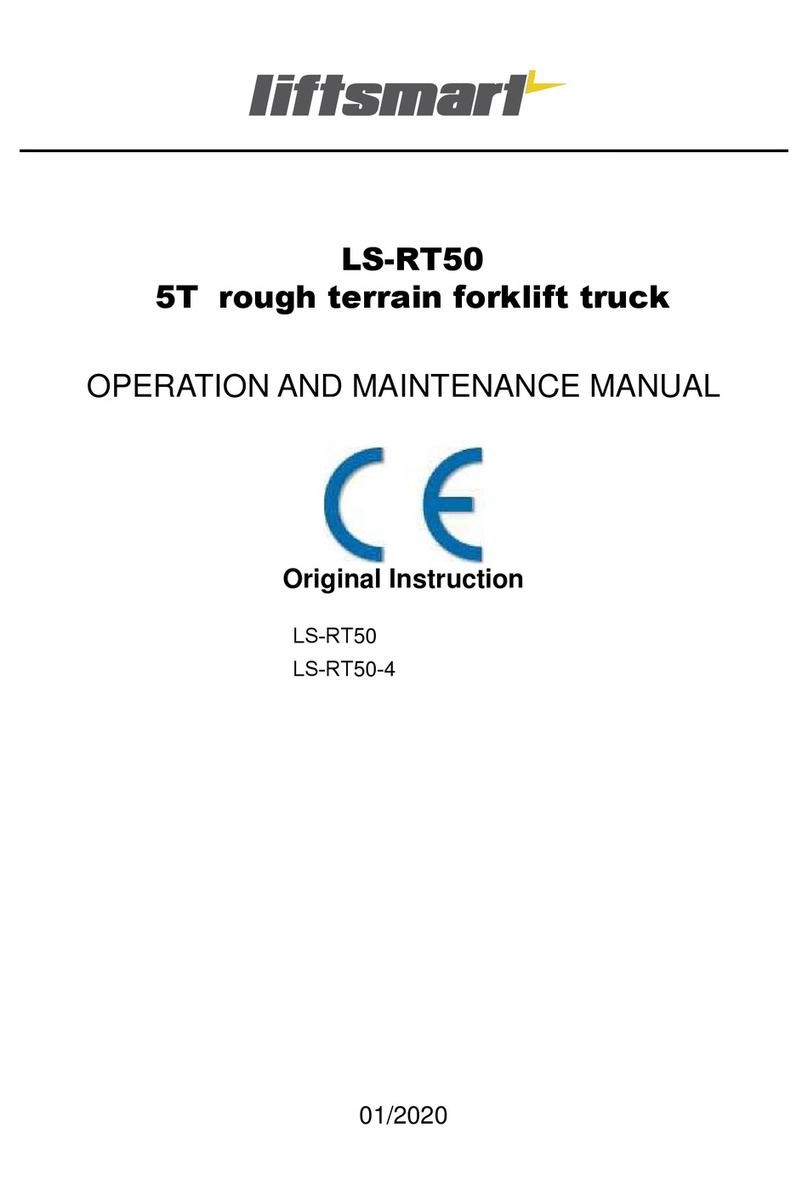
LiftSmart
LiftSmart LS-RT50 Operation and maintenance manual

Hyster
Hyster H1.50XM Safety Precautions Maintenance And Repair

Big Lift
Big Lift CB22 Operation, maintenance and parts manual
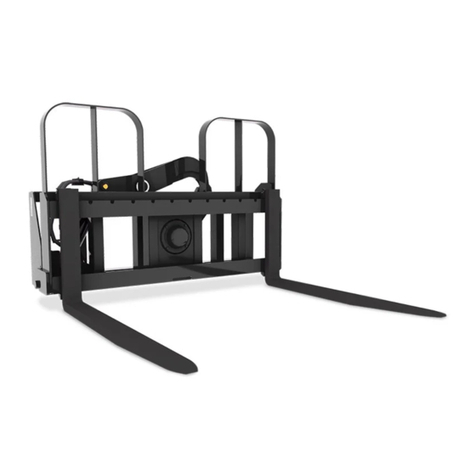
HLA
HLA HDR Series Operator's manual
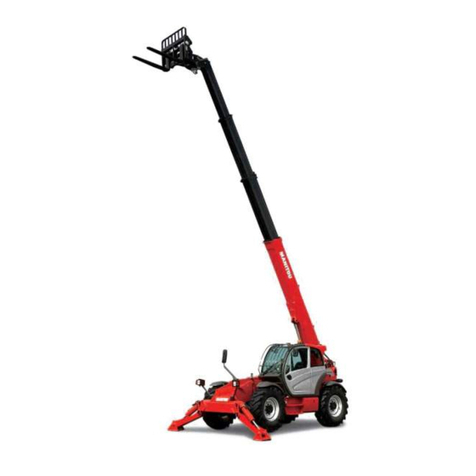
Manitou
Manitou MT 1436 R PRIVILEGE manual
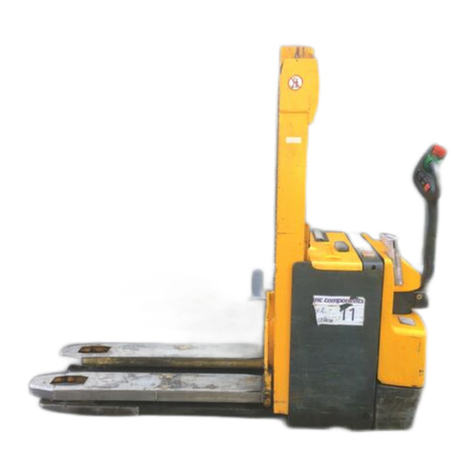
Jungheinrich
Jungheinrich EJD 220 operating instructions
